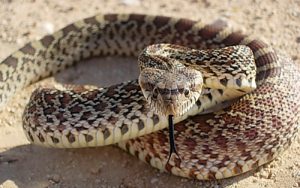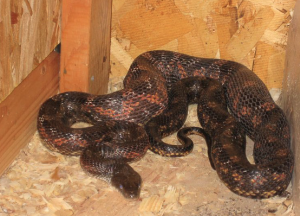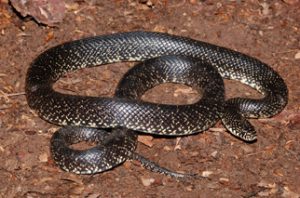I walked into the barn to gather eggs last weekend and stared with amazement when I saw a very large snake in one of my nesting boxes. It was too big too be all the way in the box and at least three feet of its tail hung onto the floor. I don’t like snakes. They scare me. Even when I know they are benign, they give me the creeps. I didn’t see a rattle on the tail and saw no red or yellow in any configuration so I decided I did not need to call for help with a venomous snake.

My inner cave woman clicked in and with murder in my heart, I grabbed a large shovel and opened the back door of the barn for better visibility. This is surely a libel to cave women since any respectable cave woman would probably know which snakes would be a threat and which were benign and knew how to deal with each kind. I sank the shovel into a spot about six inches from the snake’s head and, even with my not inconsiderable weight, I had absolutely no impact on the skin or bones. Cutting through a snake’s skin must be a job for a very sharp knife. A big knife. The snake flattened itself on the bed of hay in the nest and slithered toward the open door. I made one more attempt with the shovel which he evaded and he dived out the door and under the ramp.
I headed to the house and the internet to figure out what to do. Comparing internet photos and my memory, I decided I had acquired a bull snake (pictured above), a rat snake or a king snake. All three of these snakes are considered benign to humans and believed by most ‘authorities’ to be a beneficial on a farm since they eat mice, voles, gophers, rabbits and squirrels. All three are four to six feet long and all like chicken eggs.

I hope I don’t have a bullsnake. They also eat bird eggs and birds, climbing into trees to get to the nests. On the other hand bullsnakes are said to eat rattlesnakes. Bullsnakes can also be aggressive when attacked and my snake didn’t want anything to do with the ‘shovelcreature’, he headed for the door as fast as he could.
My snake had some pink on its sides and stomach so I am inclined to think that it was a rat snake. They like areas near water and I have a pond and a creek. They like barns and outbuildings and are the most common snake in suburban areas. But they pretend to be dead when attacked which my snake did not do. So, perhaps I have a kingsnake.
Kingsnakes also like water and trees. They are active during the daytime, particularly the morning. They eat copperheads, cottonmouths, and rattlesnakes and are resistant to the venom of pit-vipors. What a formidable creature!

Most ‘internet’ advice was that I should keep my snake. I can certainly use help with the mice and squirrels. One chicken-keeper said if you have a snake in your nests, you need better chickens. I am doubtful that anything that would dine on rattlesnake meat would be afraid of my chickens, but I spoke to the chickens about this failing on their part. I haven’t seen the snake again and don’t know if it is fearful of the shovelcreature or the chickens. I also cleaned the area with bleach so it may not like bleach.
I seem to be missing one or two eggs a day, but we have been experiencing a great deal of rain and the chickens don’t lay as well during these downpours. But, the creature may just zip in for an egg or two when I am not around. I don’t really mind if the snake helps with mice and squirrels.
I have decided to keep the snake for a while. My friend at the feed store said that is a good idea, but sometimes snakes develop a voracious appetite for eggs and will clean the nests out and also, that sometimes snakes will reproduce and I’ll wind up with three or more snakes. Then I’ll have to ‘do something’. Excess. An old friend– I complain about it almost every week. It’s what gets us in the end.